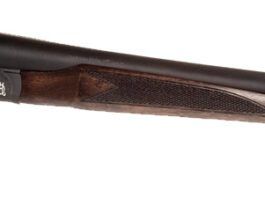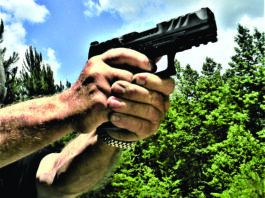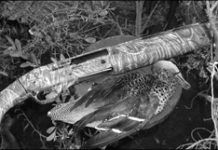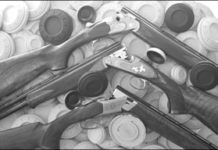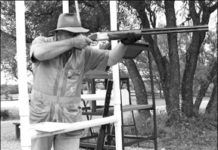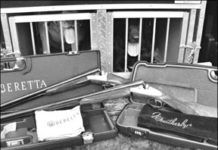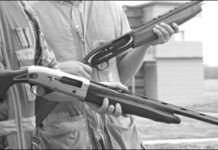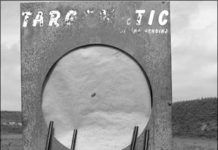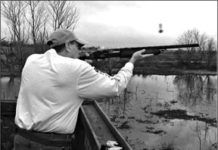Weatherby SBS Athena D’Italia ADX1228SGM
The Weatherby swings in a lovely, controllable manner and is responsive enough to address a wide range of targets. We did find the balance forward a bit on this gun, a factor that was different from the Beretta, rather than a positive or negative. Would like a better selection of chokes, but $700 between the Athena and the Beretta prices buys a lot of tubes.
Caesar Guerini Magnus 20 Gauge
This is such a pretty gun, and we think that backed by the amount of hand-finishing both inside and out, as well as the company's invaluable pit-stop program, that it's worth the higher price tag. Its unique pitch configuration will have most shooters firing above their targets. Needs porting.
Browning Cynergy Classic 20 Gauge
This gun has it all—porting, extended choke tubes, fiber-optic sights, the proper balance for sporting clays, and a main-event 12-gauge feel in a 20-gauge package. This fell short of an A rank because it came with three choke tubes and no hard case.
Winchester Super X3 Posts Narrow Win Over Benellis M2
While many scattergun enthusiasts may prefer the classic appearance of fine-grained wood and gun-metal blue steel in many shooting situations, the fall season seems to bring out the desire for a little camouflage in their shotgun collection. These firearms are designed for rugged, dependable functioning in what can be miserable weather conditions. Like the runt of a litter of puppies, these shotguns are often so ugly that they are considered attractive.With the stress on getting the job done, the two shotguns we selected for our testing are promoted as solid shooting tools, capable of handling field conditions without punishing hunters with excessive recoil or clunky handling performance.Billed as the fastest-functioning semiautomatic on the market, the Winchester Super X3 Waterfowl model is a recent addition to the Winchester line, and the Benelli M2 Field is also a fast-functioning and popular shooting tool in fields and wetlands across the country. Only one dollar separates the two shotguns manufacturers suggested retail prices, which is a rare match in a head-to-head competition between semiautomatics. Both feature slim designs and synthetic camouflage stocks and forearms, plus camouflage-coated barrels. These features are nearly a necessity for anyone venturing into the wet weather, mud and gunk typical of waterfowl hunting conditions and the unpredictable fall season for dove hunters.
Three 20-Gauges Duke It Out On the Sporting Clays Field
Serious sub-gauge clay-bird shooters have two choices available to them when it comes to guns. They can either use tube inserts in their main 12-gauge gun, or they can pick a separate firearm. Tubes certainly have distinct advantages-cost and familiar handling characteristics to name two. But many of us want a separate gun, so we wanted to see if any of todays sub-gauge sporting clays firearms were up to the task.We pitted three 20-gauge over/unders that were similar in many ways, but particularly in weight-all of them coming in at exactly 6.5 pounds. In the lineup were a $2950 Beretta 687 Silver Pigeon II Sporting No. J687435 with 30-inch barrels; a $3850 Caesar Guerini Magnus Sporting with 30-inch barrels, and a Browning Cynergy Classic Sporting No. 013245726, $3235, with 32-inch barrels.We patterned the guns at 40 yards on the National Target Companys shotgun patterning target (all proved accurately regulated). Also, we used a Shooters Ridge Steady Rest on Midway USAs MTM portable shooting bench for point-of-impact tests. Our team employed an RCBS trigger-pull gauge provided by Midway USA to measure trigger pulls.Heres how the three guns stacked up in these static tests and on the sporting clays and skeet fields:
Premier Competition STS Vs.Citori XS: We Prefer Browning
In the sporting clays world, shooters are always looking for an edge to give them an advantage over other competitors. Naturally, firearm manufacturers are more than willing to make new and improved models of shotguns available to this anxious audience. At times, the new and improved versions feature radical changes in typical shotgun dynamics, while there are some cases when just a minor tweaking is unveiled to the shooting crowd.One of the latest models to be introduced into the sporting clay market of moderately priced over-and-under shotguns is the Remington Premier Competition STS. This shotgun is a dramatic change from the companys over-and-under that once dominated the skeet and trap fields - the Remington Model 3200.Lighter, trimmer, and quicker handling, the Competition STS was developed after consultation with top sporting clay competitors who drew upon experience and personal desires to offer suggestions about features in the new model.We were able to get our hands on one of the new models and selected the well-established Browning Citori XS Sporting as a good head-to-head match up.The Browning model has been a popular shotgun in the sporting clay circuit for several years and features the same solid, dependable design of several over-and-under shotguns made in Japan for the company.With its trademark deep receiver - a full quarter-inch deeper than the Remington - that features locking lugs in the bottom of the receiver, the Browning is one of the big boys on the range and has a well-established reputation.Our ammunition selection for this test included the Winchester AA Xtra-Lite Target 2.75-inch loads that were 2.75 dram equivalent shells with 1 ounce of No. 7.5 shot traveling at 1180 fps; Remington STS Low Recoil 2.75-inch loads with a 2.5 dram equivalent, 1 1/8 ounce of No. 8 shot and a muzzle velocity of 1100 fps; and Estate Super Sport Competition Target 2.75-inch loads with 2.75 dram equivalent, 1 ounce of No. 8 shot and a muzzle velocity of 1180 fps. There were no malfunctions of any kind, and all the ammunition was very effective on the variety of clay targets attempted during our tests. Heres our test report:
Two Affordable Side-By-Sides Earn Our Praise for Field Work
Like most other American shotgunners, Gun Tests shooters often express an appreciation for the beauty of the side-by-side. It takes almost nothing to fall in love with a London best-until you start looking at price tags and the waiting times to get one even if you could afford one. The reason for what is usually viewed as exorbitant pricing for famous-label makers such as Purdey, Holland & Holland, and others is actually well founded. Not only are these guns hand made, hand finished, and hand engraved (which is why it also takes years to get one if you can pony up the cash), but it has always been harder, and thus more expensive, to regulate two barrels on a horizontal plane to shoot to the same point of impact than it is to do the same with vertically arranged tubes.These factors add up to a need-to-win-the-lottery aspect, and it is what keeps most average Joes, and that includes us at Gun Tests, from looking beyond our pumps, semi-autos, and over/unders.Truthfully, the advent of improved machining has shaved the prices down on many side-by-sides over the decades. Witness the quality guns of Spanish origin that dont come close to having five figures (or more) to the left of the decimal point. Yet you still dont see them sitting on retailer shelves, in no small part because there are more than a few makers and they dont have the name recognition that lends confidence to the casual buyer (i.e., you need to do some homework to buy one). Instead, many buyers will tend to buy better-known names, such as Weatherby and Beretta.With that in mind, we recently tested two affordable side-by-sides, the Weatherby Athena DItalia ADX1228SGM, $2925, and the Beretta 471 Silver Hawk J471210, $3625.We trotted these two field guns over several rounds of sporting clays and skeet. For accuracy, we also shot both guns standing at 40 yards and from the Shooters Ridge Steady Rest on Midway USAs MTM portable shooting bench. We fired these point-of-impact tests on the National Target Companys shotgun patterning target, and learned both guns were accurately regulated. We used an RCBS trigger-pull gauge provided by Midway USA to measure the trigger pulls on both guns barrels, and otherwise shot the heck out of them.Heres how the pair measured up in our testing:
Midrange Autoloaders: Winners From Beretta and Browning
It is rare that we pick up two guns for testing that are radically different in appearance, balance, and weight and yet dont have one that outshines the other for whatever their intended purpose might be. But thats just the case we had between our hands with the new Browning Gold Evolve Sporting semi-automatic 12 gauge 011262428, $1287, and Berettas AL391 Teknys Gold Sporting 12 gauge J391T78, $1800.Though both are aimed at the competitive sporting-clays crowds, the only commonalities these two share are that theyre both 12 gauges and their semi-automatic actions are gas-operated. One weighs significantly more than the other, they possess completely different balancing points, and when it comes to looks, one would never be mistaken for the other on a gun rack. Yet after putting these guns through the rigors of both skeet shooting and several rounds of sporting clays on a course of middling-difficult and diverse targets-and with both sports shot several times with a raging wind that really tested the dexterity of these types of firearms-we felt the race was very nearly a tie when it came to functionality, fit and finish, and handling.For accuracy, we shot both guns standing at 40 yards as measured by a Bushnell rangefinder (as if for patterning) and from the Shooters Ridge Steady Rest on Midway USAs MTM portable shooting bench for point-of-impact tests on the National Target Companys shotgun patterning target. Both proved accurately regulated). We used an RCBS trigger-pull gauge provided by Midway USA to assess trigger weights.Heres how the race unfolded.
Used Shotguns: Which Pumps Should You Buy? – And Avoid?
A rugged, reliable shooting tool can be any one of a variety of firearms available to the hunter or shooter who just wants a shotgunthat is easy on the wallet and gets the job done.These "bang-around" shotguns can face a hard life of being bounced around in the trunk of a car or stuffed in a pickup toolbox before being brought out for during dove, quail or pheasant season. They often do double duty when waterfowl season rolls around and hunters dont want to expose a fine fowling piece to the mud and gunk that go hand-in-hand with duck and goose blasting.Finding a bargain-priced firearm that will hold up to these often harsh conditions can require a trip to the used gun aisle of your local sporting goods store. Sometimes, the result is a shooting treasure that was broken in by another owner.Our excursion into the used pump shotgun arena resulted in a collection of four models that are among the most popular 12-gauge slide-actions found in hunting fields across the country.The four included: a Benelli Nova in 90 percent condition and with a price tag of $240; a Mossberg Model 835 UltraMag in 93 percent condition for $190; a Remington Wingmaster Model 870 in 97 percent condition for $400; and a Winchester Model 1200 in 95 percent condition for $230.Prices and conditions may vary for the same models in other parts of the country, but the quartet does provide a fairly comprehensive representation of hunting tools in use throughout the country.All of the members of our test team were right-handed, so our comments about access to items such as the action release are limited how we managed with the firearms. None of the pumps we tested offered ambidextrous safeties or action releases.Hunting loads limited to 2.75-inch shells were selected as the test ammunition for our four pumps to level the playing field. Some of the used firearms would handle 3-inch shells and others would not. The test ammunition included Winchester Super Speed Game Loads of 3.25 drams of powder and 7/8 ounces of No. 8 shot with a muzzle velocity of 1,350 feet per second. In addition, we performed patterning tests with some veteran heavy game loads in the form of Federal Hi-Power 3.75 dram shells with 1.25 ounces of No. 7 1/2 shot and a muzzle velocity of 1,400 fps.Heres our test report:
12 Gauges: 870 SPS Rates an A+ Over Benelli, Mossberg Guns
Most of us with at least a little gray at the temples and a background in hunting retain in memory at least one "Long Tom" shotgun that was reputed to reduce a gallon can to window screen at 60 yards. Most had at least a 32-inch, fixed-choke barrel - some longer - and were typically described by someone with a tendency toward embellishment. True, in the dark ages of barrel manufacturing, an occasional super-tight tube did fall into public hands - and was capable of impressively tight patterns. They were pretty rare, however, hence the "Long Tom" legends.But today there are shotguns and powerful, dense space-age shotshell loads out there that can, in the right hands, consistently kill waterfowl or turkeys at 60 yards and farther.Though there are those hunters who see hammering a strutting gobbler at the length of a hockey rink as a travesty against the sport, virtually everyone nevertheless wants to have that ability.
Battle of 20-Gauge Brownings: Gold Hunter or Venerable A5?
In the uncertain world of firearms production, where manufacturers have flourished then folded for a variety of reasons, opportunities are rare to match up a time-tested veteran shotgun against its new-generation version.One of those rare cases is with the Browning A5 semiautomatic, first introduced in 1902 as a revolutionary creation from the fertile mind of John M. Browning; and the Browning Gold Hunter semiautomatic, the updated version that first hit the streets in 1995.The recoil-operated A5 and its trademark hump-backed receiver quickly became the shotgun of choice for waterfowl and upland bird hunters. What it lacked in cosmetic appeal, it more than compensated with functional dependency, even in rugged hunting conditions.The gas-operated Gold Hunter followed in this tradition, finding favor with shooters interested in a solid, dependable shotgun for both tough field conditions and occasional trips to clay target courses.We were able to obtain used, but in excellent condition, 20 gauge versions of both the shotguns to conduct a head-to-head competition between the old grandfather and the young grandson. Durys Gun Shop in San Antonio, (210) 533-5431, www.durysguns.com, supplied the guns, and the prices herein reflect their actual counter prices.To help with the fair factor, several veteran members of our test group began their shotgun shooting days with an A5, but have moved on to more modern scatterguns; while some of the younger members were aware of the veteran semiautomatic, but did not have any shooting experience with the A5.Our first observation was the similarity of the two firearms, despite the age difference, with both weighing about 7 pounds and both with about the same balance between the hands. Handling qualities were nearly identical, although the hump at the back of the A5 required a little more head adjustment on the stock.Both shotguns also featured an automatic feed from the magazine to the chamber a speed-loading system that is very quick and easy. There were no function problems during any of our testing with either of the Brownings.Since both shotguns are designed for hunting conditions, our test ammunition was limited to common field loads. Only 2.75-inch loads were used because the A5 was not designed to handle 3-inch shells. We fed the two shotguns a diet of Remington ShurShot Heavy Dove one-ounce No. 7 1/2 shotshells and Winchester Heavy Target 1-ounce No. 8 shotshells (both with a muzzle velocity of 1165 fps). A small number of 7/8-ounce shells (a typical 20-gauge load) were cycled through both shotguns with no functioning problems.Heres our test report:
Benelli SBE II Is Our Pick Over Beretta, Remington Autoloaders
Its always been sound advice to buy the best quality one can afford. But Americans are often conflicted consumers since a red, white and blue trademark doesnt always mean top quality.Thats because, we suppose, U.S. manufacturers have to cut corners in order to pay decent wages, workmens compensation, life insurance, medical/dental benefits, pensions, and other sundries that dont clutter up the overhead of some off-shore competitors.One of the affected areas, in terms of quality and durability, has long been the area of semiautomatic shotguns. American designer John Brownings classic Auto-5 was made by FN in Belgium and later by Miroku in Japan a lineage shared by the companys (and sister company Winchesters) subsequent autoloaders. The Mossberg autoloaders that are still made stateside are designed with popular price points in mind, not history. Ithaca Guns USA no longer makes autoloaders; nor do Ruger or Savage, and aside from Remington, American manufacturers import semiautos rather than make one of their own in this country.In fact, when it comes to truly classic designs, Remingtons 1100 gas gun may be the only American-made autoloader to merit consideration. The 1100s autoloading predecessors the recoil-operated Model 11-48 and the pioneering gas-operated Sportsman 58 and 878 Automaster designs never caught the public fancy for a variety of reasons. And the guns successor, the 11-87, still has sufficient warts almost two decades after its introduction to merit the 1100s continued prominence in the Remington product lineup.Introduced in 1963, the 1100 still maintains sufficient interest for Remington to evolve the design more with the "Competition" in 2005 and the G-3 (for third generation) in 2006. But were not here to dissect the 1100s tried-and-true physique, which is merely dressed differently in the Competition and G-3. No, the Remington autoloader in todays limelight is the new-for-2006 Model 105Cti.Billed as lightweight, but with soft-recoil and extraordinary patterning performance, the 105Cti is the first Remington autoloader whose base model wears a four-figure price tag, which puts it into a pretty spiffy neighborhood.The Italians, on the other hand, are long-term residents of said gated community with Benellis Super Black Eagle II and Berettas 391 versions today arguably representing the royalty in autoloaders.Some may label a head-to-head comparison of these particular three guns as "apples and oranges." From here, however, its more of a "tangerines and oranges" deal. Though the Benelli SBE II (No. 10016) is a thoroughbred hunting gun, the Beretta Urika Trap Optima No. J391501, $1250, is primarily a target gun, and the Remington 105Cti (No. 29521) is still in early-design limbo between the two, they are all classy, expensive auto-loading designs worthy of state-of-the-art designation.All three 12-gauge guns feature back-bored (.735-inch interior diameters compared to the 12-gauge nominal .729) barrels, stepped ventilated ribs, three-shot magazines, cross-bolt safeties and smooth, crisp triggers. They all also came with classy plastic cases befitting 4-digit retail shotguns, with molded impressions to fit the various gun parts, choke tubes and wrenches.




























